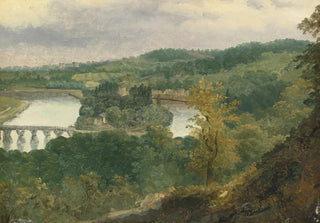Painting View of Billancourt and Bas-Meudon - Théodore Rousseau | Art print


View from behind

Frame (optional)
View of Billancourt and Bas-Meudon: a harmony between nature and industry
In this iconic artwork, Théodore Rousseau captures the essence of a landscape where nature intertwines with human influence. The green hues of the trees blend with the gray shades of the buildings, creating a striking contrast. The oil painting technique allows Rousseau to play with light, bringing each detail to life. The atmosphere conveyed by this canvas evokes tranquility, an invitation to contemplate the beauty of a world that is both wild and civilized. The delicate brushstrokes and balanced composition testify to an attentive eye on the French landscape, where each element seems to tell a story.
Théodore Rousseau: a master of Romantic landscape painting
Théodore Rousseau, an emblematic figure of the Romantic movement, redefined landscape art in 19th-century France. Influenced by Dutch masters and French scenery, he dedicated his life to painting nature in all its splendor. Rousseau was a key member of the Barbizon School, a group of artists who sought to depict nature in a realistic and poetic manner. His work had a significant impact on future generations, inspiring artists to explore themes of nature and the environment. The art print of "View of Billancourt and Bas-Meudon" is a testament to his genius and his commitment to the beauty of the natural world.
A decorative piece with multiple virtues
The art print of "View of Billancourt and Bas-Meudon" is an ideal decorative piece to enhance your interior. Whether in a living room, office, or bedroom, this painting adds a touch of elegance and serenity. Its reproduction quality guarantees fidelity to the colors and details of the original work, allowing you to appreciate the subtlety of Rousseau's technique. The aesthetic appeal of this canvas lies in its ability to create a calming atmosphere while sparking curiosity among visitors. By incorporating this piece into your decor, you choose a timeless work that evokes the beauty of the French landscape.

Matte finish

View from behind

Frame (optional)
View of Billancourt and Bas-Meudon: a harmony between nature and industry
In this iconic artwork, Théodore Rousseau captures the essence of a landscape where nature intertwines with human influence. The green hues of the trees blend with the gray shades of the buildings, creating a striking contrast. The oil painting technique allows Rousseau to play with light, bringing each detail to life. The atmosphere conveyed by this canvas evokes tranquility, an invitation to contemplate the beauty of a world that is both wild and civilized. The delicate brushstrokes and balanced composition testify to an attentive eye on the French landscape, where each element seems to tell a story.
Théodore Rousseau: a master of Romantic landscape painting
Théodore Rousseau, an emblematic figure of the Romantic movement, redefined landscape art in 19th-century France. Influenced by Dutch masters and French scenery, he dedicated his life to painting nature in all its splendor. Rousseau was a key member of the Barbizon School, a group of artists who sought to depict nature in a realistic and poetic manner. His work had a significant impact on future generations, inspiring artists to explore themes of nature and the environment. The art print of "View of Billancourt and Bas-Meudon" is a testament to his genius and his commitment to the beauty of the natural world.
A decorative piece with multiple virtues
The art print of "View of Billancourt and Bas-Meudon" is an ideal decorative piece to enhance your interior. Whether in a living room, office, or bedroom, this painting adds a touch of elegance and serenity. Its reproduction quality guarantees fidelity to the colors and details of the original work, allowing you to appreciate the subtlety of Rousseau's technique. The aesthetic appeal of this canvas lies in its ability to create a calming atmosphere while sparking curiosity among visitors. By incorporating this piece into your decor, you choose a timeless work that evokes the beauty of the French landscape.
12,34 €






